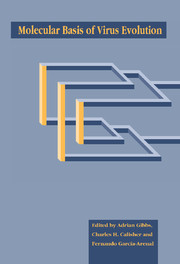Book contents
- Frontmatter
- Contents
- List of contributors
- Editors' preface
- Conference participants
- 1 Introduction and guide
- Part I The impact of viral diseases
- Part II Origins of viruses and their genes
- Part III Sources of virus variation
- Part IV Molecular interactions of viruses and their hosts
- Part V Viruses, hosts and populations
- Part VI Case studies of viral taxa; their systematics and evolution
- 18 Evolution of poxviruses and African swine fever virus
- 19 Molecular systematics of the flaviviruses and their relatives
- 20 Herpesviridae
- 21 Aphthovirus evolution
- 22 Evolution of the Bunyaviridae
- 23 Evolution of the tobamoviruses
- 24 The luteovirus supergroup: rampant recombination and persistent partnerships
- 25 The evolution of the Reoviridae
- 26 Genetic variation and evolution of satellite viruses and satellite RNAs
- 27 Molecular evolution of the retroid family
- 28 Adaptation of members of the Orthomyxoviridae family to transmission by ticks Patricia
- 29 The Order Mononegavirales: evolutionary relationships and mechanisms of variation
- 30 The molecular evolution of the human immunodeficiency viruses
- 31 Molecular evolution of papillomaviruses
- 32 Molecular systematics of the Potyviridae, the largest plant virus family
- 33 Evolution of alphaviruses
- 34 Evolution of influenza viruses: rapid evolution and stasis
- Part VII Techniques for viral systematics
- Index
26 - Genetic variation and evolution of satellite viruses and satellite RNAs
Published online by Cambridge University Press: 04 May 2010
- Frontmatter
- Contents
- List of contributors
- Editors' preface
- Conference participants
- 1 Introduction and guide
- Part I The impact of viral diseases
- Part II Origins of viruses and their genes
- Part III Sources of virus variation
- Part IV Molecular interactions of viruses and their hosts
- Part V Viruses, hosts and populations
- Part VI Case studies of viral taxa; their systematics and evolution
- 18 Evolution of poxviruses and African swine fever virus
- 19 Molecular systematics of the flaviviruses and their relatives
- 20 Herpesviridae
- 21 Aphthovirus evolution
- 22 Evolution of the Bunyaviridae
- 23 Evolution of the tobamoviruses
- 24 The luteovirus supergroup: rampant recombination and persistent partnerships
- 25 The evolution of the Reoviridae
- 26 Genetic variation and evolution of satellite viruses and satellite RNAs
- 27 Molecular evolution of the retroid family
- 28 Adaptation of members of the Orthomyxoviridae family to transmission by ticks Patricia
- 29 The Order Mononegavirales: evolutionary relationships and mechanisms of variation
- 30 The molecular evolution of the human immunodeficiency viruses
- 31 Molecular evolution of papillomaviruses
- 32 Molecular systematics of the Potyviridae, the largest plant virus family
- 33 Evolution of alphaviruses
- 34 Evolution of influenza viruses: rapid evolution and stasis
- Part VII Techniques for viral systematics
- Index
Summary
Introduction
Satellite viruses and satellite RNAs are sub-viral microbes which depend on another virus, referred to as the ‘helper virus’, for their replication within a host cell. The basis of satellite dependence is not completely understood, but it is presumed that satellite genomes are replicated by the RNA-dependent RNA polymerase encoded by the helper virus. Along with viroids, satellites are the smallest and simplest biological entities known, with single-stranded RNA genomes ranging from 194 to 1376 nt. Satellites are uniquely prevalent in plant hosts, and have been found associated with 28 different plant viruses from diverse virus groups (Roossinck, Sleat & Palukaitis, 1992). To date, no examples of satellites of animal viruses are known. The only satellite-like entity associated with an animal virus, hepatitis delta virus, is not a true satellite because it is capable of autonomous replication, and appears to need its helper virus only for encapsidation and transmission (Taylor, 1990).
The classical definition of a satellite involves three main features (Murant & Mayo, 1982). These are that satellites are not capable of replicating in the absence of the helper virus, they are not required for the life cycle of the helper virus, and that they share little or no sequence similarity with the helper virus genome. Thus, satellites differ from other sub viral entities such as viroids, which are capable of independent replication in a host cell, and defective interfering (DI) RNAs, which are comprised of helper virus genetic sequences. Satellites often interfere with the replication of their helper viruses, and the symptoms caused by helper virus/satellite co-infections can differ dramatically from those of the helper virus alone.
- Type
- Chapter
- Information
- Molecular Basis of Virus Evolution , pp. 385 - 403Publisher: Cambridge University PressPrint publication year: 1995
- 3
- Cited by



